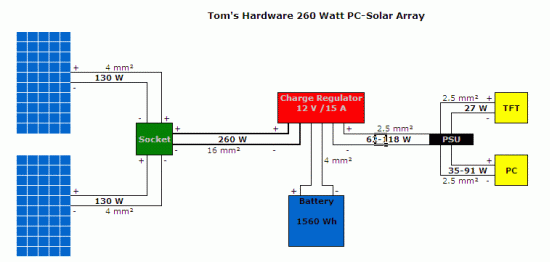Do-It-Yourself Solar-Powered PC: Live Test
Do-It-Yourself Solar-Powered PC: Live Test
Solar Panels
| Solar Panel Yield |
| Power Generated: | Row 0 - Cell 1 |
| Voltage: | Row 1 - Cell 1 |
| Currrent: | Row 2 - Cell 1 |
| Solar Panel Efficiency: | Row 3 - Cell 1 |
| Row 4 - Cell 0 | |
| Start Solar Power Generation: | Row 5 - Cell 1 |
| End Solar Power Generation: | Row 6 - Cell 1 |
| Total Time: | Row 7 - Cell 1 |
| Row 8 - Cell 0 | |
| Today's Peak: | W, At: |
| Solar Power Generated Today: | (Ø ) |
| Yesterday: | Row 11 - Cell 1 |
| Total Solar Power Generated : | Row 12 - Cell 1 |
We begin logging how the amount of power generated when the yield exceeds 10 watts. We stop in the evening when the yield falls below 10 watts. During the day, we only count periods where more than 10 watts are generated.
| Row 0 - Cell 0 |
| Currently Generated Power |
| Row 2 - Cell 0 |
| Watts |
| Block Diagram Of Our Solar Plant |
| Info |
On this page you can find information about the amount of power currently being generated by the solar panels. The maximum yield of our solar plant is 260 watts. To counterbalance the effects of aging, the solar panels have a slightly higher yield when they leave the factory. As a result, our two panels can produce a good deal more energy than their specified nominal capacity when they get full sunlight. Their efficiency depends on the intensity and the incident angle of the sunlight. Power generation data is logged every day from 0:00 until 23:59 (24-hour time format) and then added to the statistics page.
We begin counting the time that power is produced as soon as the yield exceeds 10 watts. We stop counting when it drops below 10 watts. If the yield rises above 10 watts again at a later time, the ending time is automatically updated. The average power generated is logged every 7.5 seconds. If that average value is greater than 10 watts, 7.5 seconds are added to the time sheet for total power generated. We set the limit to 10 Watts, because the solar regulator also uses some power and the battery bleeds a little bit of power as well. Additionally, the PC's power supply draws a standby current.
If you'd like to go back and start reading about our solar-powered PC project from the beginning, have a look at the articles leading up to our live test:
- Do-It-Yourself Solar-Powered PC: Technical Foundations
- Do-It-Yourself Solar-Powered PC: Hardware
- Do-It-Yourself Solar-Powered PC: Solar Components
Get Tom's Hardware's best news and in-depth reviews, straight to your inbox.
Current page: Do-It-Yourself Solar-Powered PC: Live Test
Next Page Do-It-Yourself Solar-Powered PC: Live TestTom's Hardware is the leading destination for hardcore computer enthusiasts. We cover everything from processors to 3D printers, single-board computers, SSDs and high-end gaming rigs, empowering readers to make the most of the tech they love, keep up on the latest developments and buy the right gear. Our staff has more than 100 years of combined experience covering news, solving tech problems and reviewing components and systems.
-
c911darkwolf Something me and my wife were talking about. Solar panels are expensive, but if you make a small investment it will cut down your power bill every month or you can make a large investment go independent and sell excess back to the electric company.Reply








